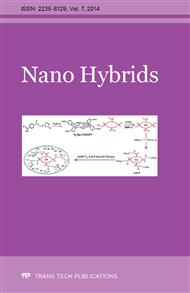[1]
J.G. Barber, A.M. Handorf, T.J. Allee, W.J. Li, Braided nanofibrous scaffold for tendon and ligament tissue engineering, Tissue Eng. Part A 19 (2013) 11-12.
DOI: 10.1089/ten.tea.2010.0538
Google Scholar
[2]
D.M. Doroski, K.S. Brink, J.S. Temenoff, Review: Techniques for biological characterization of tissue-engineered tendon and ligament, Biomaterials 28 (2007) 187-202.
DOI: 10.1016/j.biomaterials.2006.08.040
Google Scholar
[3]
J.W. Freeman, M.D. Woods, C.T. Laurencin, Tissue engineering of the anterior cruciate ligament using a braid–twist scaffold design, J. Biomech. 40 (2007) 2029-2036.
DOI: 10.1016/j.jbiomech.2006.09.025
Google Scholar
[4]
X. Wang, Ch. Han, X. Hu, H. Sun, Ch You, Ch. Gao, Y. Haiyang, Review article: Applications of knitted mesh fabrication techniques to scaffolds for tissue engineering and regenerative medicine, J. Mech. Behav. Biomed. Mater. 4 (2011) 922-932.
DOI: 10.1016/j.jmbbm.2011.04.009
Google Scholar
[5]
S. Marzougui, L. Kilani, S. Ben Abdessalem, F. Sakli, Dynamic Fatigue of Braided Textile Ligaments, Arab. J. Sci. Eng. 39 (2014) 2205-2214.
DOI: 10.1007/s13369-013-0777-9
Google Scholar
[6]
S. Sahoo, S.L. Toh, J.C.H. Goh, PLGA nanofiber-coated silk microfibrous scaffold for connective tissue engineering, J. Biomed. Mater. Res. B Appl. Biomater. 95 (2010) 19-28.
DOI: 10.1002/jbm.b.31678
Google Scholar
[7]
S. Canoglu, F. Basturk, F. Suvari, Investigating the effects of draw ratio, hot-pin temperature, and overfeeding on the color values of air-jet textured polyester yarns, J. Text. Inst. 105 (2014) 547-552.
DOI: 10.1080/00405000.2013.827389
Google Scholar
[8]
R.L. Horan, A.L. Collette, Ch. Lee, K. Antle, J. Chen, G.H. Altman, Yarn design for functional tissue engineering, J. Biomech. 39 (2006) 2232-2240.
DOI: 10.1016/j.jbiomech.2005.07.007
Google Scholar
[9]
R. Ravichandran, S. Liao, N.C. CH, C.K. Chan, M. Raghunath, S. Ramakrishna, Effects of nanotopography on stem cell phenotypes, World J. Stem Cells 1 (2009) 55-66.
DOI: 10.4252/wjsc.v1.i1.55
Google Scholar
[10]
F.L. Zhou, R.H. Gong, I. Porat, Nanocoating on filaments by electrospinning, Surface & Coatings Technology 204 (2009) 621-628.
DOI: 10.1016/j.surfcoat.2009.08.053
Google Scholar
[11]
F.L. Zhou, R.H. Gong, I. Porat, Nano-coated hybrid yarns using electrospinning, Surface & Coatings Technology 204 (2010) 3459-3463.
DOI: 10.1016/j.surfcoat.2010.04.021
Google Scholar
[12]
L.A. Smith, P.X. Ma, Nano-fibrous scaffolds for tissue engineering, Colloids Surf., B 39 (2004) 125-131.
Google Scholar
[13]
Z. Ma, M. Kotaki, R. Inai, S. Ramakrishna, Potential of Nanofiber Matrix as Tissue-Engineering Scaffolds, Tissue Eng. 11 (2005) 101-109.
DOI: 10.1089/ten.2005.11.101
Google Scholar
[14]
Ph. Gibson, H. Schreuder-Gibson, D. Rivin, Transport properties of porous membranes based on electrospun nanofibers, Colloids and Surfaces, A: Physicochemical and Engineering Aspects 187-188 (2001) 469-481.
DOI: 10.1016/s0927-7757(01)00616-1
Google Scholar
[15]
B.M. Min, G. Lee, S.H. Kim, Y.S. Nam, T.S. Lee, W.H. Park, Electrospinning of silk fibroin nanofibers and its effect on the adhesion and spreading of normal human keratinocytes and fibroblasts in vitro, Biomaterials 25 (2004) 1289-1297.
DOI: 10.1016/j.biomaterials.2003.08.045
Google Scholar
[16]
E. Naghashzargar, D. Semnani, S. Karbasi, H. Nekoee, Application of intelligent neural network method for prediction of mechanical behavior of wire-rope scaffold in tissue engineering, J. Text. Inst. 105 (2014) 264-274.
DOI: 10.1080/00405000.2013.835904
Google Scholar
[17]
E. Triantaphyllou, S.H. Mann, Using The Analytic Hierarchy Process For Decision Making in Engineering Applications: Some Challenges, Inter'l Journal of Industrial Engineering: Applications and Practice 2 (1995) 35-44.
Google Scholar
[18]
E.M. Dehaghi, D. Semnani, M. Morshed, S. Sadri, E. Vatankhah, A Digital Signal Processing Technique to Measure the Surface Roughness of Nano- Fibrous Scaffolds, Proceedings of 11th World Textile Conference Autex, France, Mulhouse, 474-478, 2011.
Google Scholar
[19]
K.J. Stout, Development of Methods for the Characterization of Roughness in Three Dimensions; Penton Press, 1993.
Google Scholar
[20]
Surface Measurement Parameters for Wyko® Optical Profilers, Veeco Instrument Inc., 2002.
Google Scholar
[21]
V.K. Kothari, N.B. Timble, Air-jet texturing: Effect of jet type and some process parameters on properties of air-jet textured yarns, Indian Journal of Fiber and Textile Research 16 (1991) 29-38.
DOI: 10.1177/004051759106101206
Google Scholar
[22]
B. M. Min, G. Lee, S. H. Kim, Y. S. Nam, T. S. Lee, W. H. Park, Electrospinning of silk fibroin nanofibers and its effect on the adhesion and spreading of normal human keratinocytes and fibroblasts in vitro, Biomaterials 25 (2004), 1289-1297.
DOI: 10.1016/j.biomaterials.2003.08.045
Google Scholar


